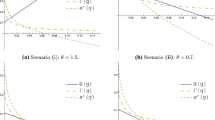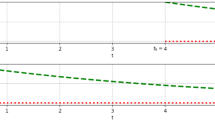Abstract
We characterize optimal consumption, capital, and population growth of a production economy under critical-level utilitarianism. First, we show that neither classical utilitarianism nor average utilitarianism can avoid a corner solution for the population growth rate, in that under the former, population grows at the maximum speed (the so-called repugnant conclusion) while under the latter, it grows at the minimum. Second, we show that critical level utilitarianism yields an interior solution for the population growth rate provided the critical level belongs to a positive, open interval. Finally, we characterize the transition to the steady state and perform comparative dynamics analysis.








Similar content being viewed by others
Notes
With first-best intra-generational redistribution, the objective function becomes population size, N, times average utility, u: Nu.
To see this, for a, b, and γ ∈ (0,1), concavity of u implies u(γa + (1 − γ)b) > γu(a) + (1 − γ)u(b) by Jensen’s inequality. Setting a = X/N and b = 0 (using u(0) = 0), and γ = N/(1 + N) gives the result.
Among other non-utilitarian principles, see, for example, Golosov et al. (2007).
Therefore, nothing precludes comparisons of alternatives where individuals have utilities below the critical level. This implies that adding a person with negative utility to a population may be preferred to an alternative where all individuals have positive utilities. This is the so called “sadistic” conclusion (see Arrhenius (2000) and Blackorby et al. (2005)).
See Blackorby et al. (2005) for an extensive assessment of this and other criteria.
See also Dasgupta (1969) in the context of CU.
For notational purposes in the remainder of this work we omit time subscripts whenever no ambiguity results.
The co-state λ is the shadow value of N, consequently when λ is positive, N is too low and should be increased.
Note that \(\mathop {\lim }\limits_{T\to \infty } \lambda _T e^{-\int\limits_{t_0 }^T {(\rho -n_s )ds} }=N_{t_0 } ^{-1}\mathop {\lim }\limits_{t\to \infty } e^{-\rho t}\lambda _t N_t \), which is equal to zero if the transversality condition holds.
References
Arrhenius G (2000) An impossibility theorem for welfarist axiologies. Econ Philos 16(2):247–66
Barro RJ, Becker GS (1989) A reformulation of the economic theory of fertility. Q J Econ 103(1):1–25
Becker GS, Barro RJ (1988) Fertility choice in a model of economic growth. Econometrica 57(2):481–501
Blackorby C, Bossert W, Donaldson D (1995) Intertemporal population ethics: critical-level utilitarian principles. Econometrica 63(6):1303–20
Blackorby C, Bossert W, Donaldson D (1997) Birth-date dependent population ethics: critical-level principles. J Econ Theory 77(2):260–84
Blackorby C, Bossert W, Donaldson D (2002) Critical-level population principles and the repugnant conclusion. Department of Economics, University of British Columbia Discussion paper no 02-16
Blackorby C, Bossert W, Donaldson D (2005) Population issues in social choice theory, welfare economics, and ethics. Cambridge University Press, Cambridge
Broome J (1992) Counting the cost of global warming. White Horse Press, London
Cass D (1965) Optimum growth in an aggregative model of capital accumulation. Rev Econ Stud 32(3):233–40
Dasgupta PS (1969) On the concept of optimum population. Rev Econ Stud 36(107):295–318
Golosov M, Jones LE, Tertilt M (2007) Efficiency with endogenous population growth. Econometrica 75(4):1039–71
Hurka T (1983) Value and population size. Ethics 93(3):496–507
Hurka T (2000) Comment on ‘population principles with number-dependent critical levels’. Unpublished manuscript, Department of Philosophy, University of Calgary
Jaeger K, Kuhle W (2009) The optimum growth rate for population reconsidered. J Popul Econ 22(1):23–41
Koopmans TC (1965) On the concept of optimal economic growth. Pontif Acad Sci Scr Varia 28:225–287. Reprinted as Cowles Foundation Paper 238 (1966)
Ng YK (1986) Social criteria for evaluating population change: an alternative to the Blackorby-Donaldson criterion. J Popul Econ 29(3):375–381
Parfit D (1976) On doing the best for our children. In: Bayles M (ed) Ethics and populations. Schenkman Publishing Company Inc., Cambridge, pp 100–115
Parfit D (1984) Reasons and persons. Oxford University Press, Oxford
Ramsey FP (1928) A mathematical theory of saving. Econ J 38(152):543–559
Samuelson PA (1975) The optimum growth rate for population. Int Econ Rev 16(3):539–544
Shiell L (2008) The repugnant conclusion and utilitarianism under domain restrictions. J Public Econ Theory 10(6):1011–1031
Tännsjö T (2002) Why we ought to accept the repugnant conclusion. Utilitas 14(3):339–59
Acknowledgements
We are grateful to two anonymous referees and the editor for suggestions that greatly improved the paper. We also thank participants at the seminars held at the University of Pisa (Italy) and Durham (UK) and at the MMF 2010 Annual Conference (Cyprus) for their helpful suggestions and comments. We are also grateful to Elvio Arcinelli for his useful comments and suggestions. All remaining errors are our own responsibility. Renström gratefully acknowledges funding from Durham Business School.
Author information
Authors and Affiliations
Corresponding author
Additional information
Responsible editor: Alessandro Cigno
Rights and permissions
About this article
Cite this article
Renström, T.I., Spataro, L. The optimum growth rate for population under critical-level utilitarianism. J Popul Econ 24, 1181–1201 (2011). https://doi.org/10.1007/s00148-010-0348-2
Received:
Accepted:
Published:
Issue Date:
DOI: https://doi.org/10.1007/s00148-010-0348-2




